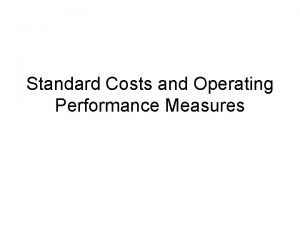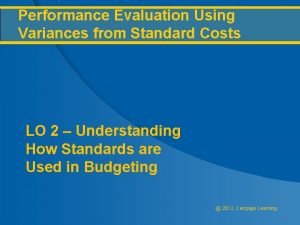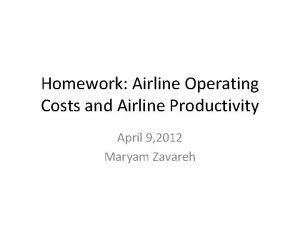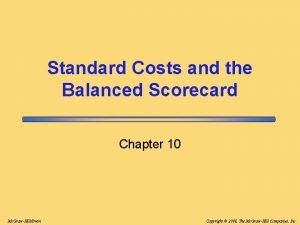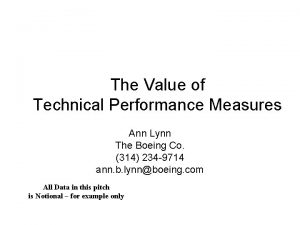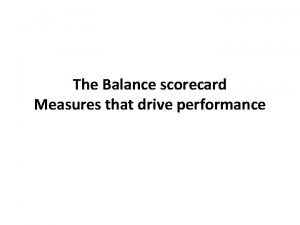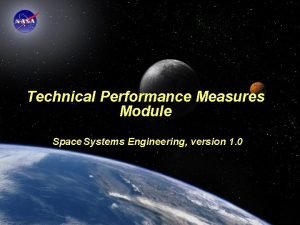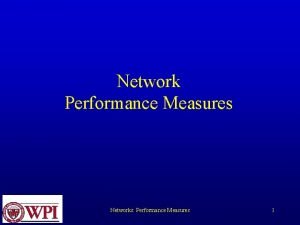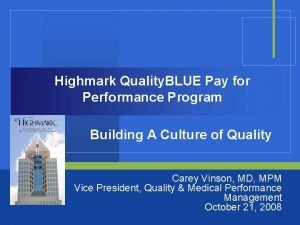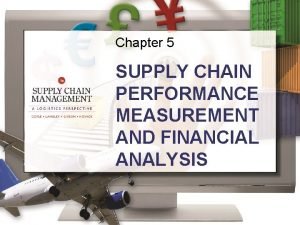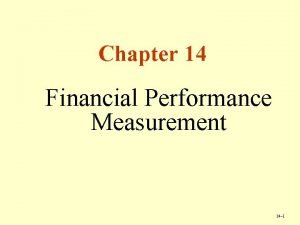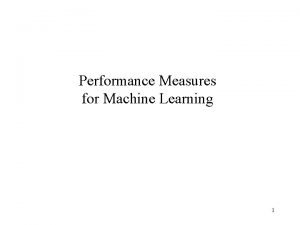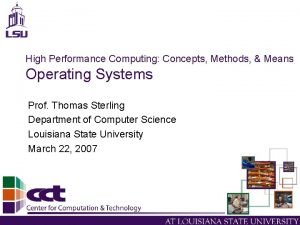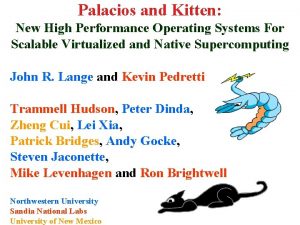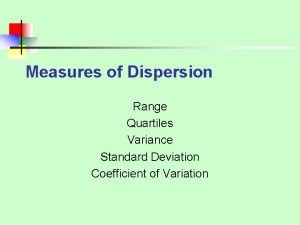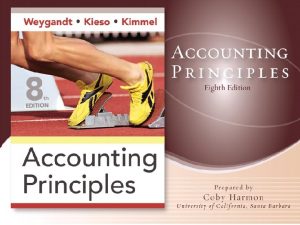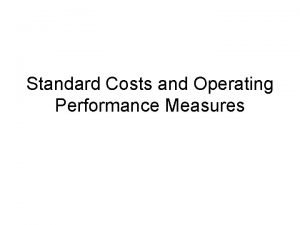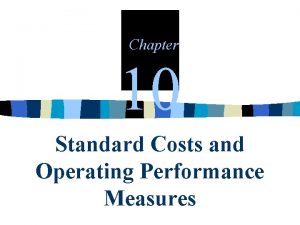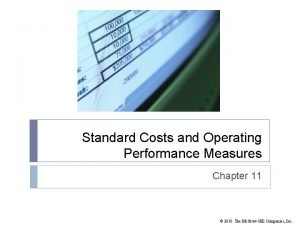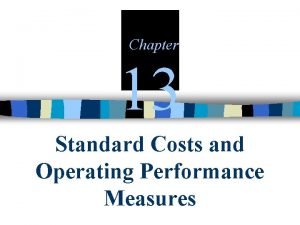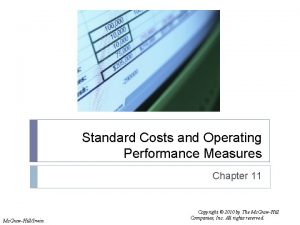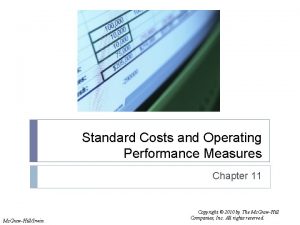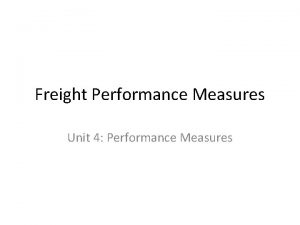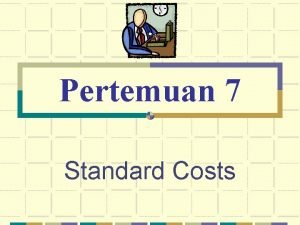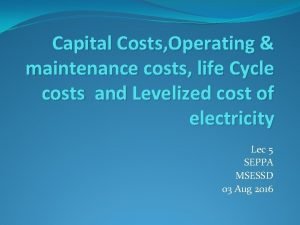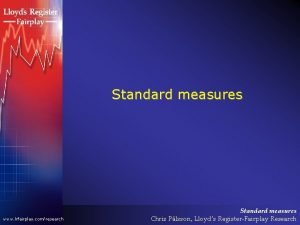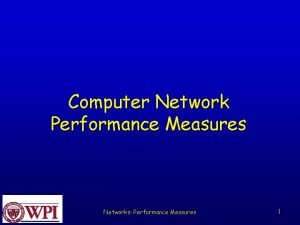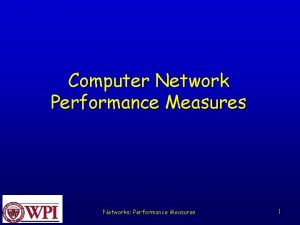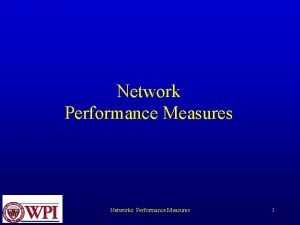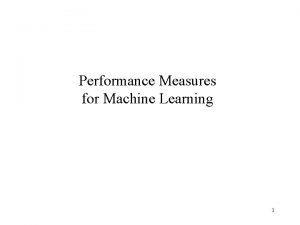Standard Costs and Operating Performance Measures Standard Costs



















- Slides: 19

Standard Costs and Operating Performance Measures

Standard Costs Standards are benchmarks or “norms” for measuring performance. In managerial accounting, two types of standards are commonly used. Quantity standards specify how much of an input should be used to make a product or provide a service. Price standards specify how much should be paid for each unit of the input. Examples: Firestone, Sears, Mc. Donald’s, hospitals, construction and manufacturing companies.

Key performance indicators VS Actual performance KPI/Pre cost target Actual/Post cost Variance Direct material 10. 00 per unit 11. 00 (A) Direct labour 5. 50 0. 50(A) Variable overhead 2. 00 per unit 2. 00 - Fixed overhead 1. 00 - Full cost 5. 00 per unit 18. 50

Standard Costs Amount Deviations from standards deemed significant are brought to the attention of management, a practice known as management by exception. Standard Direct Labor Direct Material Type of Product Cost Manufacturing Overhead

Variance Analysis Cycle Identify questions Receive explanations Take corrective actions Conduct next period’s operations Analyze variances Prepare standard cost performance report Begin

PDCA P=PLAN D=DO C=CHECK A=ACTION

Setting Standard Costs Accountants, engineers, purchasing agents, and production managers combine efforts to set standards that encourage efficient future operations.

Setting Standard Costs Should we use ideal standards that require employees to work at 100 percent peak efficiency? Engineer I recommend using practical standards that are currently attainable with reasonable and efficient effort. Managerial Accountant

Setting Direct Material Standards Price Standards Quantity Standards Final, delivered cost of materials, net of discounts. Summarized in a Bill of Materials.

Setting Standards Six Sigma advocates have sought to eliminate all defects and waste, rather than continually build them into standards. As a result allowances for waste and spoilage that are built into standards should be reduced over time.

Setting Direct Labor Standards Rate Standards Time Standards Often a single rate is used that reflects the mix of wages earned. Use time and motion studies for each labor operation.

Setting Variable Manufacturing Overhead Standards Rate Standards Quantity Standards The rate is the variable portion of the predetermined overhead rate. The quantity is the activity in the allocation base for predetermined overhead.

Price and Quantity Standards Price and quantity standards are determined separately for two reasons: The purchasing manager is responsible for raw material purchase prices and the production manager is responsible for the quantity of raw material used. The buying and using activities occur at different times. Raw material purchases may be held in inventory for a period of time before being used in production.

A General Model for Variance Analysis Price Variance Difference between actual price and standard price Quantity Variance Difference between actual quantity and standard quantity

A General Model for Variance Analysis Price Variance Materials price variance Labor rate variance VOH rate variance Quantity Variance Materials quantity variance Labor efficiency variance VOH efficiency variance

A General Model for Variance Analysis Actual Quantity × Actual Price Actual Quantity × Standard Price Variance Standard Quantity × Standard Price Quantity Variance

Standard Cost Card – Variable Production Cost A standard cost card for one unit of product might look like this:

Actual results for the month of March Actual production 5000 units Actual material used and purchased 17500 Kg Actual material cost Rs. 66500. 00 Labour hours produced 11250 hours Labour cost incurred Rs. 160312. 5 Variable overhead Rs. 28125. 00 Calculate all possible variances from the pre cost standard

Variance analysis Ultra Shine Company manufactures a cleaning solvent. The company employs both skilled and unskilled workers. The standard and actual material and labor information is presented below. Budgted production sales 60000 units. Standard: Material A: 30. 25 gallons @ Rs. 1. 25 per gallon = 37. 80 Skilled Labor: 4 hours @ Rs. 12 per hour = 48. 00 Variable production overhead 4 hours @ Rs. 3. 00 per hour= 12. 00 Fixed production overhead = 05. 00 Full cost per unit = 102. 80 Profit margin per unit = 40. 00 Selling price = 142. 80 Post order costing: Material A: 10, 716 gallons purchased and used @ Rs. 1. 50 per gallon Skilled labor hours: 1, 950 @ Rs. 11. 90 per hour Variable production cost Rs. 7800. 00 Fixed production overhead cost Rs. 310, 000. 00 During the current month Ultra Shine Company manufactured 500 55 gallon drums and total revenue earned Rs. 7, 508, 250. 00. Calculate all possible variances
 Standard costs and operating performance measures
Standard costs and operating performance measures Performance evaluation using variances from standard costs
Performance evaluation using variances from standard costs Repeated measures design vs independent measures design
Repeated measures design vs independent measures design Airline operating costs
Airline operating costs Standard costs and balanced scorecard
Standard costs and balanced scorecard Technical performance parameters
Technical performance parameters Balanced scorecard measures that drive performance
Balanced scorecard measures that drive performance Technical performance measures systems engineering
Technical performance measures systems engineering Network performance measurement in computer networks
Network performance measurement in computer networks Highmarl true performance quality measures
Highmarl true performance quality measures Financial measures of supply chain performance
Financial measures of supply chain performance Starbucks financial objectives
Starbucks financial objectives Pipeline performance measures
Pipeline performance measures Performance measures for machine learning
Performance measures for machine learning High performance operating system
High performance operating system High performance operating system
High performance operating system Variance vs standard deviation
Variance vs standard deviation Most companies that use standards set them at
Most companies that use standards set them at Meaning of standard costing
Meaning of standard costing Ultra shine company manufactures a cleaning solvent
Ultra shine company manufactures a cleaning solvent
